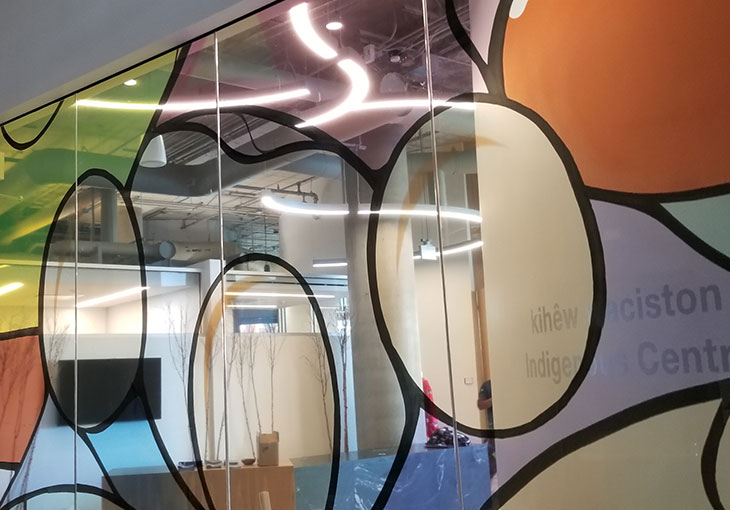New kihêw waciston Indigenous Student Centre Welcomes all at MacEwan University
March 16, 2020

Our hope is that all people – all people – walk out of kihêw waciston feeling inspired, hopeful, and connected.Terri Suntjens, kâ-nêkânêstahk iyiniw pamihtamowina, Director of Indigenous Initiatives at MacEwan
MacEwan University recently shared the story of designing the new kihêw waciston Indigenous Centre. It’s a new space on the growing downtown Edmonton campus that we’re exceptionally proud to help design. A few excerpts from its deep dive are below, and you can read the full article here.
Three years ago, Indigenous initiatives at the university were expanded to include not only Indigenous students, but all faculty and staff members and the community, and the resulting demand quickly outstripped the capacity of the old kihêw waciston space. It made sense then, that the journey of creating a new home for kihêw waciston would also be grounded in the openness, learning and trust that Indigenization demands.
Stuart MacLean, MacEwan University’s Associate VP, Facilities, says that this project was unlike any other he has seen in his 20 years at the university. Rather than starting with discussions around functional infrastructure and improving building conditions, the process of creating a new kihêw waciston was rooted in Indigenous ways of knowing and being.
We weren’t talking about Indigenization with this project, we were living it.Stuart MacLean
From the beginning, Elders and Knowledge Keepers were deeply involved, sharing their perspectives, teachings, ceremonies, and ways of knowing and being with the design team, including the university’s facilities and kihêw waciston staff, and DIALOG’s team of architects, interior designers, landscape architects, and mechanical, electrical and structural engineers.
Translating layered, complex ideas and teachings into building specifications and blueprints that would facilitate sharing Indigenous knowledge fell to lead architect Donna Clare of DIALOG. “There was an openness from the Indigenous community to help us understand this project through their lens,” she says. “A gentleness and a willingness to tell us when we did not get things right.”
The result of this open, honest and inclusive design process based on truth and learning is a space built to facilitate each of those things on an ongoing basis.

“The welcome desk represents the pipe in our sacred pipe teachings – the stone is the bowl of the pipe and the wood is the stem,” explains Terri. That’s meaningful, she says, because pipe ceremonies are places where participants are truthful, and where decisions and agreements are made.
It’s just one example of how the elements of kihêw waciston are steeped in meaning. Look down and you’ll see the hardwood floor is positioned to reflect the four directions. Look behind the desk you’ll see tipi poles. To the left an office is flagged with a bright block of yellow, representing its easterly direction on the medicine wheel. Everywhere there are connections to ceremony, treaty, learning, healing – and the land.

Based on photography by Wilfred A. Buck, science facilitator at the Manitoba First Nations Education Resource Centre, this special feature shares the story of the achakos ininewuk (the Star People). “We will have Elders come in and do traditional teachings of of the constellations,” says Terri.
Under the night sky installation is a hammock-like swing (the wîwîp’son Indigenous Therapeutic Swing created by Dr. Darlene Auger), which uses the traditional parenting practice of rocking babies to sleep. For adults, it’s a way to reduce stress, promote healing and reconnect with one’s self.


A round segment of grass-green carpeting is underfoot and floor-to-ceiling windows create a connection to the outdoors, shaping a space for ceremony, teaching and socializing that takes its inspiration from the tipi.
“We always open and end in circle because in our circle process, there is no hierarchy,” says Roxanne. “We come together and share food, culture and teachings. Everyone is allowed to speak their minds and their hearts regardless of their worldview. We leave our titles and academic credentials at the door. It’s a place to be with each other.”
kihêw waciston means “eagle’s nest” in Cree, reflecting one of the centre’s key goals: to provide students with a place to grow and be nurtured. Staff at the centre work hard to “feather the nest” – to provide a warm, welcoming space for students to gather, study, relax and connect with their roots.

To the north there is a firepit and space for a tipi. To the south, the university’s Treaty 6 marker–a sculpture entitled Mother Bear Prays for Earth’s Healing. And along the western walls of the centre, a medicine garden will be cultivated.
These outdoor elements not only announce the presence of kihêw waciston–and the university’s commitment to Indigenization–to people passing by, they also support land-based teaching, an important part of many Indigenous cultures. In order for that teaching to be authentic, the land itself had to be authentic.